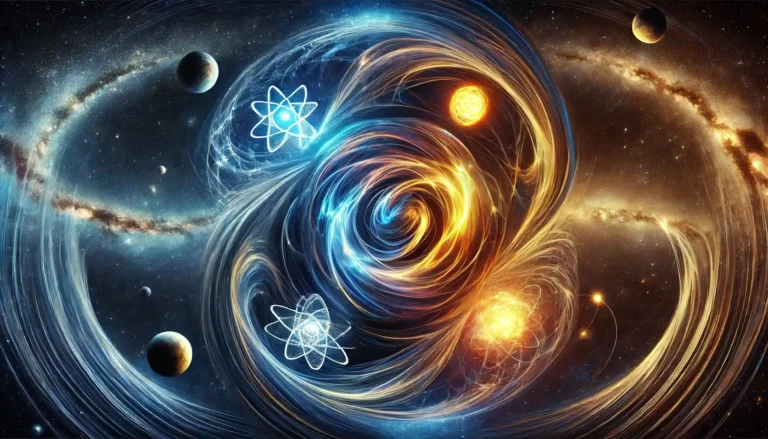The Theory of Everything
String Theory – The Theory of Everything
We constantly observe the objects around us such as massive mountains, buildings or even tiny grains of sand and dust.
Have you ever wondered how these objects are formed and what components they are made of?
Let’s imagine you break a brick into smaller and smaller pieces with a hammer. Initially you will get small fragments and as you keep breaking you will eventually get fine powder.
But this is the limit of what our naked eye can observe. Beyond this it is impossible for us to see smaller parts. However that doesn’t mean the structure of matter ends here. Let’s dive deeper into the elements that make up matter and discover its ultimate structure.
Ancient Concept of Atoms: Democritus’s Theory
In 460 BC the Greek philosopher Democritus first introduced the idea that matter is composed of an indivisible unit.
He believed that if you continuously divide a piece of matter you will eventually reach a tiny particle that can no longer be divided. He named this smallest particle atom which in Greek means indivisible.
He also suggested that everything around us is made up of these atoms. Although the meaning of “atom” implies indivisibility today in modern physics, the term “atom” refers to the basic unit of matter even though we now know it can be further divided.
Breakthrough Discoveries: Electrons Protons and Neutrons
After Democritus’s concept, more than 2,300 years passed without significant changes in the idea of atoms.
However in 1897 J.J. Thomson discovered a particle smaller than the atom which he named the electron. This discovery proved that atoms are not indivisible, as Democritus had theorized. In 1911 physicist Ernest Rutherford found that in addition to electrons, atoms also contain a central nucleus which is much smaller than the atom.
In 1919 Rutherford discovered a positively charged particle in the nucleus, which he called the proton. Later in 1932 James Chadwick discovered another particle in the nucleus, the neutron. These discoveries showed that the atom is made of three smaller particles: electrons protons and neutrons.
Discovery of Quarks: A New Level of Matter
Until the 1960s scientists believed that everything in the universe was made up of three fundamental particles electrons protons and neutrons.
However in 1964 physicists Murray Gell Mann and George Zweig proposed the existence of even smaller particles inside protons and neutrons called quarks. In 1968 scientists at the Stanford Linear Accelerator attempted to break protons and investigate their structure.
The experiment revealed that protons are not fundamental particles but are made of two up quarks and one down quark. Similarly neutrons are made of one up quark and two down quarks.
This discovery revealed that everything we see around us is made up of just three types of fundamental particles: electrons up quarks and down quarks.
Are Quarks and Electrons the Final Components?
Conventional theory suggests that quarks and electrons are the most fundamental particles.
But are they really the smallest units?
Or can they be divided further?
This question led to the development of a new theory called String Theory also known as The Theory of Everything.
What is String Theory?
According to String Theory the most fundamental particles like quarks and electrons are not point like particles but rather tiny one dimensional strings.
These strings vibrate in different ways, and the way they vibrate creates different types of particles. Imagine the string of an ektara (a traditional musical instrument) vibrating to produce sound.
Similarly the strings in String Theory vibrate to form particles. The vibrations of these strings result in different types of particles such as quarks, electrons, photons and other elementary particles.
Strings as the Building Blocks of Matter
String Theory suggests that particles such as quarks and electrons are not the smallest units.
If broken down these particles are made of even smaller strings or filaments. These strings are incredibly tiny and vibrate in different ways to produce different particles.
For example the vibration of a photon will be different from that of an electron. The theory describes that everything in the universe is made from these vibrating strings. Each string vibrates differently, resulting in the creation of various particles.
There are two types of strings: Closed Strings (looped strings) and Open Strings (strings with open ends).
The Core Idea of String Theory
In physics String Theory proposes that instead of point like particles all matter is composed of tiny one-dimensional strings.
The mass charge spin and other properties of particles are determined by the different vibrational states of these strings. One of the string’s possible vibrational states matches a theoretical particle known as the graviton which is believed to carry the force of gravity.
Although the graviton has not been discovered yet physicists believe it must exist as every fundamental force has a corresponding carrier particle.
String Theory: A Quantum Gravity Theory
String Theory is a form of quantum gravity theory that attempts to merge quantum mechanics and general relativity.
It aims to explain various unresolved questions in physics including the behavior of black holes and the creation of the universe.
The Contributions of String Theory to Physics
String Theory has significantly contributed to understanding many fundamental questions in physics.
It has provided solutions to several complex problems in cosmology nuclear physics and quantum mechanics. The theory has helped scientists develop mathematical models to describe the Big Bang black holes and other cosmic phenomena.
Supersymmetry and String Theory
In the 1990s Superstring Theory was developed which connects bosons (force-carrying particles) and fermions (matter particles) through supersymmetry. By the mid-1990s five different versions of superstring theory were created. These versions together describe 11 dimensions and are now known as M-Theory.
In 1997 physicists discovered the relationship between String Theory and Quantum Field Theory called ADS/CFT Correspondence which provides us a deeper connection between these two fundamental frameworks.
The Birth of Two Major Theories in the 20th Century
In the early 20th century two of the most important scientific theories were introduced. One was Albert Einstein’s General Theory of Relativity which explains gravity and how space and time interact to shape the universe.
The other was Max Planck’s Quantum Theory which describes how matter behaves at the smallest scale from atoms to subatomic particles.
By the late 1970s these two theories were enough to explain most of the events in the universe from the behavior of atoms to the evolution of stars and galaxies. However despite their success some big questions remain unanswered especially the problem of Quantum Gravity.
The Challenge of Quantum Gravity
One of the toughest challenges in modern physics is Quantum Gravity. There are four fundamental forces in nature and three of them (the strong nuclear force, the weak nuclear force and the electromagnetic force) follow the rules of quantum mechanics.
But gravity is different it doesn’t follow the rules of quantum principles. To solve this scientists need a quantum theory of gravity that aligns with Einstein’s theory of relativity.
Whenever scientists try to apply quantum mechanics to gravity they run into problems. Besides figuring out how to describe gravity using quantum theory other big questions include understanding the structure inside black holes and what happened in the universe before the Planck epoch.
String Theory and Its Evolution
In recent decades String Theory has made progress including the discovery of dualities mathematical transformations that link different theories. Scientists working on String Theory found several of these dualities suggesting that all versions of String Theory are part of one unified theory known as M-Theory.
String Theory has also provided new ideas about the nature of black holes and gravitational forces. However, while trying to understand the quantum aspects of black holes scientists have encountered a few paradoxes that still need solving.
The Quest for a Unified Theory
Because String Theory includes all the fundamental forces including gravity, some physicists believe it may eventually become a theory that explains everything about the universe.
But there are still many questions about whether String Theory can explain the specific properties of our universe.
Particles Are Really Waves
In modern particle physics, the particles we once thought were fundamental don’t actually exist as standalone objects. Instead, these particles are actually waves in fields.
So, what we call particles are really just tiny excitations or quanta of these fields. Therefore, the universe is made up of fields, not particles, and these fields create waves when they are excited.
Feynman Diagrams and Quantum Field Theory
In the early 20th century, physicists like Richard Feynman developed Quantum Field Theory to handle the complex calculations involving particle interactions.
To simplify these interactions, Feynman introduced Feynman Diagrams, which show how particles move and interact.
In String Theory, instead of a one-dimensional path for a particle, we now look at a two-dimensional surface representing the movement of a string. The length of a string in this theory is about 10^-35 meters, known as the Planck length, and at this scale, quantum gravity effects become important.
Types of Superstring Theories
There are several versions of Superstring Theory, such as Type I, Type IIA, Type IIB, and two versions of Heterotic String Theory—one based on SO(32) and the other on E8×E8.
Type I strings are open, meaning they have two ends, while closed strings form loops. On the other hand, Type IIA, Type IIB, and Heterotic Strings consist only of closed loops.
Extra Dimensions and Compactification
To understand extra dimensions, we first need to know what a dimension is. A dimension refers to the number of coordinates required to specify a point in space.
0 Dimensions (Point): A point has no length, width, or height.
1st Dimension (Line): A line has length but no width or height.
2nd Dimension (Plane): A flat surface has both length and width.
3rd Dimension (Space): In the 3D world we live in, objects have length, width, and height.
4th Dimension (Time): In Einstein’s theory of relativity time is the fourth dimension, combined with the three dimensions of space to form spacetime. In this model gravity is seen as the bending of spacetime caused by mass.
Higher Dimensions and Compactification
Even though spacetime is described with four dimensions, some scientists believe there may be even more dimensions. Adding extra dimensions can sometimes make certain theories easier to understand mathematically.
In String Theory extra dimensions are necessary for the math to work:
Bosonic String Theory requires 26 dimensions.
Superstring Theory requires 10 dimensions.
M-Theory requires 11 dimensions.
Compactification is the process of “shrinking” extra dimensions to a size that’s too small to observe. For instance in particle physics Calabi-Yau manifolds are often used to compact these extra dimensions. These are six-dimensional spaces commonly used in String Theory.
Gravity and Extra Dimensions
Some scientists think that our visible universe is just a four-dimensional part of a higher-dimensional space. In these models the fundamental force-carrying particles except for gravity are confined to this four dimensional space. Gravity however comes from closed strings and can move between dimensions.
This might explain why gravity is weaker than other forces. The graviton (the particle believed to carry gravity) is thought to be produced by closed strings which may quickly move into other dimensions making gravity appear weaker in our universe.

















